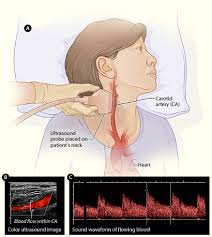Carotid artery intima-media thickness is a marker for coronary artery disease
Keywords:
CIMT, atherosclerosis, marker, CADAbstract
Although cardiac mortality has declined over the past four decades, coronary artery disease (CAD) remains the leading cause of mortality worldwide. Considering the importance of CAD and effectiveness of primary prevention interventions (as are statins), is present an increasing interest in how to identify individuals with increased risk of cardiovascular incidents before they occur. Ultrasonography in B-mod of carotid arteries nowadays increasingly is using as a noninvasive and sophisticated method for evaluating the atherosclerotic load in various clinical situations. The aim of this study was to analyze the relationship between intima-media thickness of the carotid artery with the presence and extent of coronary disease. 50 patients with positive stress echocardiography are referred for coronary angiography for coronary atherosclerosis assessment. All these patients, and to 50 healthy volunteers are evaluated by B-mode ultrasound of common carotid arteries for carotid intima-media thickness (CIMT) assessment. It was shown that patients with CAD have higher values of CIMT than healthy volunteers (0.96 mm ± 0.16 mm versus 0.64 mm ± 0.0.89 mm; T-test=16.053, p<0.0001). Values of CIMT were in direct correlation with severity and extent of coronary artery disease. Values of CIMT were greater in the subgroup with three vessel disease and in the subgroup of left main coronary artery disease than they were in the subgroup with single vessel coronary artery disease and in subgroup with two vessel coronary artery disease (1.08 mm ± 0.23 mm and 1.05 mm ± 0.16 mm versus 0.87 mm ± 0.125 mm and 0.93 mm ± 0.06 mm; coefficient of correlation was r=0. 473 and this was statistically significant p<0.01). In conclusion, CIMT can be used to predict the presence and extent of coronary atherosclerosis.
References
World Health Organization, 2012. Cardiovascular disease: prevention and control. Available at: http://www.who.int/mediacentre/factsheets/fs310/en/. [Accessed 29 February 2012].
Lloyd-Jones, D., Adams, R., Carnethon, M., De Simone, G., Ferguson, T., Flegal, K., et al., 2009. Heart disease and stroke statistics 2009 update: a report from the American Heart Association Statistics Committee and Stroke Statistics Subcommittee. Circulation. 119, e21–e181.
Myerburg, R.J., Castellanos, A., 2011. Cardiac arrest and sudden cardiac death. In: Bonow RO, Mann DL, Zipes DP, Libby P, editors. Braunwald’s heart disease, a textbook of cardiovascular medicine. 9th Ed. Philadelphia, PA: Elsevier Saunders; pp. 845–884.
Thompson, J.B., Blaha, M., Resar, J.R., Blumenthal, R.S., Desai, M.Y., 2008. Strategies to reverse atherosclerosis: an imaging perspective. Curr. Treat. Options. Cardiovasc. Med. (10), 283-93.
Nguyen-Thanh, H.T., Bruno, S.B., 2009. Screening for Subclinical Coronary Artery Disease Measuring Carotid Intima Media Thickness. Am. J. Cardiol. 104, 1383–1388.
Heiss, G., Sharrett, A.R., Barnes, R., Chambless, L.E., Szklo, M., Alzola, C., 1991. Carotid atherosclerosis measured by B-mode ultrasound in populations: associations with cardiovascular risk factors in the ARIC study. Am. J. Epidemiol. 134, 250 –256.
Liviakis, L., Pogue, B., Paramsothy, P., Bourne, A., Gill, A.E., 2010. Carotid intima-media thickness for the practicing lipidologist. J. Clin. Lipidology. 4, 24–35.
Touboul, P., Labreuche, J., Vicaut, E., Amarenco, P., 2005. Carotid intima-media thickness, Plaques and Farmingham risk score as independent determinants of stroke risk. Stroke. 36, 1741-1745.
Adams, M.R., Nakagomi, A., Keech, A., 1995. Carotid intima-media thickness in only weakly correlated with the extent and severity of coronary artery disease. Circulation. 92, 2127-2134.
Sicari, R., Nihoyannopoulos, P., Evangelista, A., Kasprzak, J., Lancellotti, P., Poldermans, D., Voigt, U.J., Zamorano, L., 2008. Stress echocardiography expert consensus statement. Eur. J. Echocardiogr. 9, 415-437.
Stein, J.H., Korcarz, C.E., Hurst, R.T., Lonn, E., Kendall, C.B., Mohler, E.R., Najjar, S.S., Rembold, C.M., Post, W.S., 2008. Use of carotid ultrasound to identify subclinical vascular disease and evaluate cardiovascular disease risk: a consensus statement from the American Society of Echocardiography Carotid Intima-Media Thickness Task Force. J. Am. Soc. Echocardiogr. 21, 93–111.
Sidney. C., Smith, J.r., Philip G., Scott, M., Grundy. Prevention Conference, V., 2000. Beyond Secondary Prevention: Identifying the High-Risk Patient for Primary Prevention: Executive Summary. Circulation. 101, 111-116.
Nambi, V., Chambless, L., He, M., Folsom, R.A., Mosley, T., Boerwinkle, E., Ballantyne, M.C., 2012. Common carotid artery intima–media thickness is as good as carotid intima–media thickness of all carotid artery segments in improving prediction of coronary heart disease risk in the Atherosclerosis Risk in Communities (ARIC) study. Eur. Heart J. 33, 183–190.
Roman, M.J., Naqvi, T.Z., Gardin, J.M., Gerhard-Herman, M., Jaff, M., Mohler, E., 2006. Clinical application of noninvasive vascular ultrasound in cardiovascular risk stratification: a report from the American Society of Echocardiography and the Society of Vascular Medicine and Biology. J. Am. Soc. Echocardiogr. 19, 943–954.
Chambless, L.E., Heiss, G., Folsom, A.R., Rosamond, W., Szklo, M., Sharrett, A.R., Clegg, L.X., 1997. Association of coronary heart disease incidence with carotid arterial wall thickness and major risk factors: the Atherosclerosis Risk in Communities (ARIC) study, 1987–1993. Am. J. Epidemiol. 146, 483–94.
O’Leary, D.H., Polka, J.F., Kronmal, R.A., Manolio, T.A., Burke, G.L., Wolfson, SK. Jr. 1999. Carotid-artery intima and media thickness as a risk factor for myocardial infarction and stroke in older adults. N. Engl. J. Med. 340, 14 –22.
Demircan, S., Tekin, A., Tekin, G., Topcu, S., Yigit, F., Erol, T., Katircibasi, T., Sezgin, A.T., Baltali, M., Ozin, B., Müderrisoglu, H., 2005. Comparison of carotid intima-media thickness in patients with stable angina pectoris versus patients with acute coronary syndrome. Am. J. Cardiol, 96, 643-644.
Chambless, L.E., Folsom, A.R., Clegg, L.X., Sharrett, A.R., Shahar, E., Nieto, F.J., Rosamond, W.D., Evans, G., 2000. Carotid wall thickness is predictive of incident clinical stroke: the Atherosclerosis Risk in Communities (ARIC) study.Am. J. Epidemiol. 151, 478–487.
Morteza, N., et all., 2006. From Vulnerable Plaque to Vulnerable Patient—Part III: Executive Summary of the Screening for Heart Attack Prevention and Education (SHAPE) Task Force Report. Am. J. Cardiol. 98[suppl], 2H–15H.

Published
How to Cite
Issue
Section
Copyright (c) 2013 S. Abdushi, F.U. Kryeziu, F. Mazreku

This work is licensed under a Creative Commons Attribution-NonCommercial-NoDerivatives 4.0 International License.



